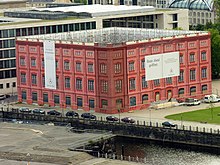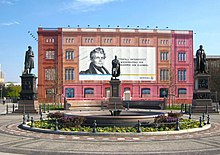
The Reichstag, a historic legislative government building on Platz der Republik in Berlin, is the seat of the German Bundestag. It is also the meeting place of the Federal Convention, which elects the President of Germany.

The Berlin Palace, formally the Royal Palace, adjacent to the Berlin Cathedral and Museum Island in the Mitte area of Berlin, was the main residence of the House of Hohenzollern from 1443 to 1918. Expanded by order of King Frederick I of Prussia according to plans by Andreas Schlüter from 1689 to 1713, it was thereafter considered a major work of Prussian Baroque architecture. The royal palace was one of Berlin’s largest buildings and shaped the cityscape with its 60-meter-high (200 ft) dome.

U55 was an U-Bahn line in the German capital city of Berlin. It connected the new Berlin Hauptbahnhof, or main railway station, to an interchange with the S-Bahn at Brandenburger Tor. It had only three stations, did not connect to any other U-Bahn line, and was operated as a shuttle line using a single train.

The Kommandantenhaus, also called Alte Kommandantur, on Unter den Linden boulevard in the historic centre of Berlin is the former headquarter of the city's commandant. It was built in 1654 and renovated from 1873 to 1874 in Renaissance Revival style. Damaged during the Allied bombing in World War II and later demolished, it was rebuilt from 2001 to 2003 as part of the Forum Fridericianum. Since then, it has been home to a representative office of Bertelsmann. The Kommandantenhaus was the workplace of the French writer Stendhal, the German politician Otto Wels and the German Resistance member Paul von Hase.

Paul Ludwig Simon, also known as Paul Louis Simon, was a German architect and professor at the Building Academy (Bauakademie) in the faculty of architectural physics and a privy architectural counsellor at the Prussian Higher Council of Architecture in Berlin. In the latter position Simon was the predecessor of Karl Friedrich Schinkel. Simon was serving as well as Senior Director of public works for the Marches of Pomerania and Prussia. Beside these fields of activity Simon did – at that time in Europe well known – research work in the field of Electrochemistry and Galvanism. He published different articles on these subjects in German scientific journals – as for example “Annals of Physics”.

Reconstruction in architectural conservation is the returning of a place to a known earlier state by the introduction of new materials. It is related to the architectural concepts of restoration and preservation, wherein the most extensive form of reconstruction is creating a replica of a destroyed building.
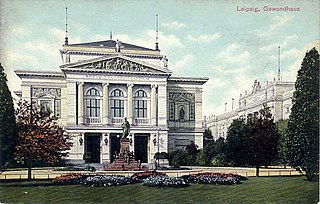
Martin Carl Philipp Gropius was a German architect.
Hermann Johannes Gustav Pundt was a leading architectural historian and Professor in the University of Washington Department of Architecture.

Johann August Karl Soller was a Prussian, and later, German architect. He was one of the most important of Karl Friedrich Schinkel's pupils and is regarded as a representative of the Schinkel school. Soller became an influential proponent of Rundbogenstil, a Romanesque revival architectural style that became popular in German-speaking lands and among German diaspora during the 19th century.
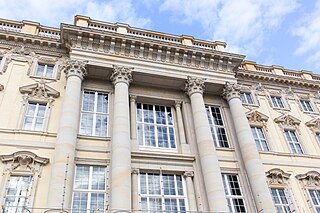
The Foundation for the Humboldt Forum in the Berlin Palace is a German foundation established by the Government of Germany to create the Humboldt Forum museum in the reconstructed City Palace, Berlin. It works closely with the Federal Government Commissioner for Culture and Media. Following a resolution passed by the German Parliament, the Bundestag, it receives funding from the Federal Ministry of Transport, Building and Urban Development.

Walter Kolbow is a former German politician of the SPD.

Edmund Collein was an East German architect and urban planner. He is also known for his photography while studying at the Bauhaus art school.

Richard Lucae was a German architect and from 1873 director of the Berliner Bauakademie.

Wilhelm Stier was a German architect and university teacher at the Berlin Bauakademie.

Kurt Liebknecht was a German architect. After 1937 he pursued his career as a Soviet architect, except during a hiatus of eighteen months spent in a Soviet jail as a suspected spy.

Kai Wegner is a German politician of the Christian Democratic Union (CDU) who has been serving as Governing Mayor of Berlin since April 2023. He served as a member of the Bundestag, the German federal parliament, from 2005 to 2021. In 2019, he became the chairman of the CDU in Berlin.
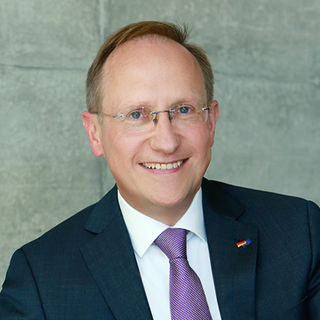
Klaus-Dieter Gröhler is a German lawyer and politician of the Christian Democratic Union (CDU) and former public servant who served as a member of the Bundestag from the state of Berlin from 2013 until 2021. From 2011 until 2013, he worked as the city councillor responsible for building and planning in western Berlin's Charlottenburg-Wilmersdorf district.

Salomo Sachs was a Jewish Prussian architect, astronomer, Prussian building official, mathematician, drawing teacher for architecture, teacher for machine drawings, building economist, writer, author of non-fiction and textbooks and universal scholar. He attained the rank of a royal building inspector and with his cousin Major Meno Burg they were the only men in the Prussian civil service who had not renounced their Jewish faith.
Bruno Flierl was a German architect, architecture critic, and writer. His work focused on architecture, urban development, and city planning of East Germany. He assisted in the design of the Pariser Platz and argued for the preservation of the Palace of the Republic in the debate over the restoration of the Berlin Palace.

The reconstruction of the Berlin Palace took place from 2013 to 2020, incorporating donor-funded facades and components of the Baroque palace building. In 2002, the German Bundestag decided to partially rebuild the palace, which was demolished in 1950, thus continuing the restoration of Berlin's Historic Center. The three facades, which date back to 1713 and were designed by Andreas Schlüter, were reconstructed with the palace dome by Friedrich August Stüler from 1853. The project was widely discussed in society. According to the decision of the international expert commission in April 2002, the reconstructed palace serves as the seat of the Humboldt Forum.

